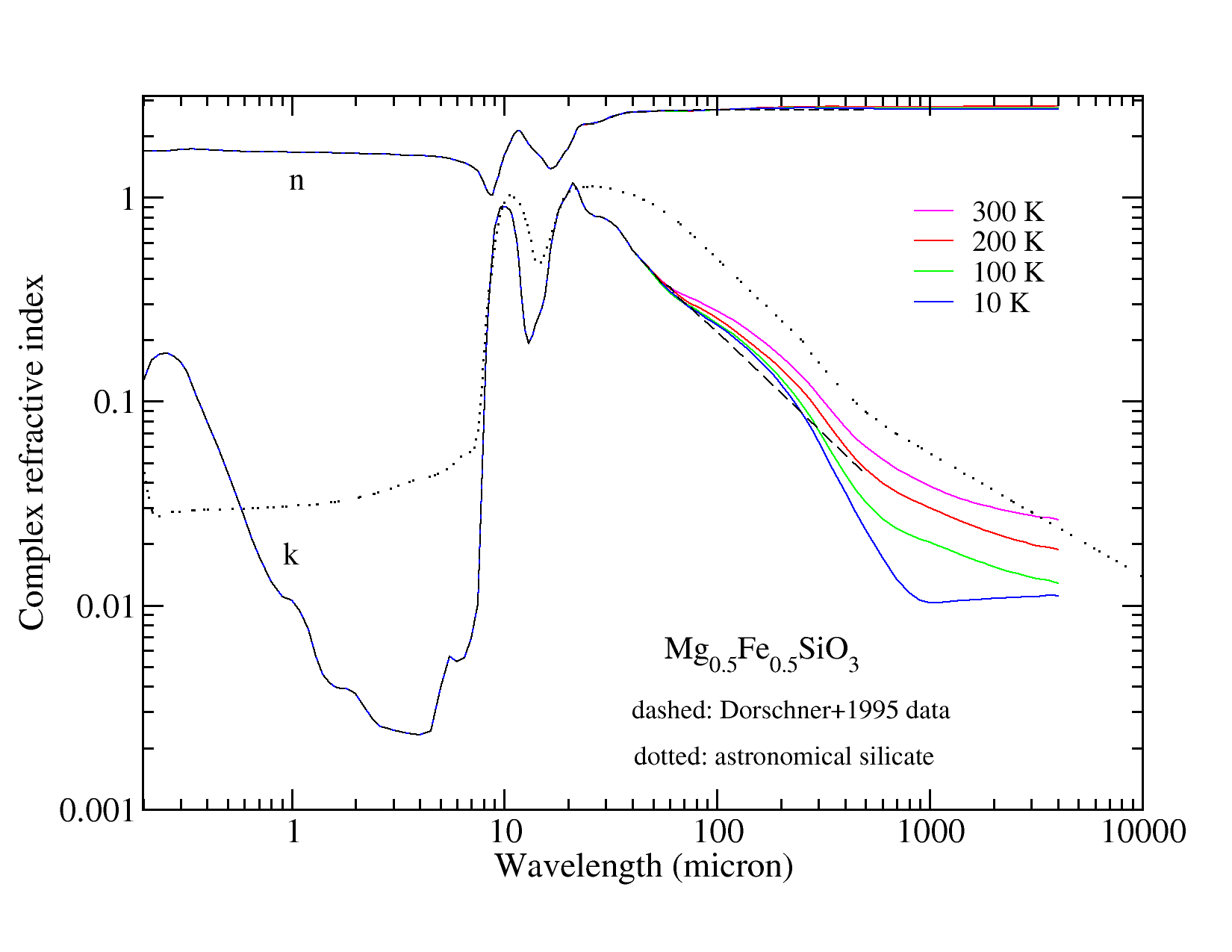Current research: Far-infrared to millimeter dust opacity
The continuum dust opacity at far-infrared and millimeter wavelengths is an astronomically very important quantity, for instance for determining the amount of cold dust in interstellar clouds or in cold disks. Since from laboratory work there are only few data available in this wavelength range, this quantity and its wavelength and temperature dependence are not yet very well known. However, observations have found indications for a strong T-dependence of the spectral opacity slope for galactic dust [1]. The dust opacity at these wavelengths, depending on the kind of object, may consist of contributions from amorphous and crystalline silicate dust, often with inclusions, mantels, and separate populations of iron compounds, carbonaceous materials, and ices. Low-energetic absorption processes, such as defect-induced phonon absorption, relaxation absorption, phonon-difference processes, and electric conductivity are responsible for the long-wavelength opacity of these dust constituents and cause its dependence on the environmental temperature.
We studied and still study the far-infrared and sub-millimeter dust opacity within two DFG-funded research projects. One of them was focusing on interstellar dust, especially on amorphous silicates, and was part of the DFG priority programme SPP 1573 "Physics of the Interstellar Medium". This project is a collaboration with Frank Lewen from I. Phys. Institut der Universität Köln (Cologne). In Cologne, a millimeter-wave spectrometer for wavelengths up to 4 mm, has been developed [2]. From the results of this project, we derived complex refractive indices of Mg/Fe silicate glasses over a wide wavelength range (see Fig. 1). The second project is part of the DFG Research Unit (FOR 2285) "Debris disks in planetary systems" and is dedicated to dust ejected from minor bodies (mainly by collisions) in planetary systems. Here, we collaborate with theorists, mineralogists, and other laboratory astrophysicists to derive information on such systems from observations of dust (thermal emission, scattering of starlight). Data on dust optics, collision mechanics, mineralogy, and irradiation physics is needed for that, apart from a complex theory. To measure more effectively dust opacities at low temperatures and long wavelengths (where the cold dust located far from the star emits), our lab has been equipped with a Time-domain THz spectrometer by DFG. Within this project, we have derived T-dependent far-infrared optical constants of crystalline silicates, and water ice. Currently, we are working on carbonaceous materials (Fig. 2).
[1] Desert, F.-X.; Macias-Perez, J. F.; Mayet, F.; et al., 2008, "Submillimetre point sources from the Archeops experiment: very cold clumps in the Galactic plane", Astron. Astrophys., 481, 411
[2] Potapov, A., Lewen, F., Mutschke, H., Mohr, P., Schlemmer, S., 2014, "Total power millimeter-wave spectrometer for measurements of dust opacity at cryogenic temperatures", Review of Scientific Instruments, Volume 85, Issue 7, id.073102
Project Team (Jena): Pierre Mohr, Harald Mutschke, Jonas Greif, Christian Kranhold, Susanne Bock, Denny Häßner
Collaboration: Cornelia Jäger, Alexey Potapov, Falko Langenhorst (Jena), Jürgen Blum (Braunschweig), Sebastian Wolf (Kiel), Alexander Krivov, Torsten Löhne (Jena), Frank Lewen & Fabio Eupen (Cologne),
 |
 |
|
Fig. 1 Optical constants of a Mg/Fe silicate glass at different temperatures - compared to previous room-temperature data and the "astronomical silicate"^(Li & Draine 2001) |
Fig. 2 Illustration of the production of carbonaceous materials by pyrolysis of cellulose. Bottom: quartz tube in which the pyrolysis at temperatures up to 1000°C was performed under Ar gas. Top: Pyrolysis products. |
